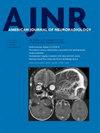In vitro assessment of vascular injury following stent retriever retraction in clinically-relevant endothelialized silicone models.
IF 3.7
3区 医学
Q2 CLINICAL NEUROLOGY
引用次数: 0
Abstract
Mechanical thrombectomy devices have potential to injure the vessel during treatment of acute ischemic stroke. The goal of the current work was to tailor in vitro endothelialized silicone models for stent retriever assessment and to evaluate endothelial injury following treatment by various stent retriever designs and sizes. Clinically-relevant neurovascular geometries were first modeled out of silicone, then sterilized, coated with fibronectin, placed in bioreactors, seeded with human endothelial cells, and cultivated under flow. Several sizes of two different commercially available stent retrievers were then deployed in, and retracted through, vessels. Vessels were immediately harvested and stained. Endothelial injury, identified as denudation, was quantified using ImageJ. Results illustrated that endothelial injury ranged from 16-18% in wire/microcatheter-only treated vessels, 37-61% in 1-pass treatments, and 52-70% in 2-pass treatments. Overall this work showcases an in vitro approach for early stage assessment of the extent and location of vascular injury following stent retriever retraction.在临床相关的内皮化硅胶模型中,对支架牵引器牵引后的血管损伤进行体外评估。
在治疗急性缺血性中风期间,机械血栓切除装置可能会损伤血管。当前工作的目标是定制体外内皮化硅胶模型,用于支架取栓器评估,并评估各种支架取栓器设计和尺寸治疗后的内皮损伤。首先用硅胶制作临床相关的神经血管几何模型,然后灭菌、涂上纤连蛋白、放入生物反应器、播种人内皮细胞并在流动状态下培养。然后,将两种不同尺寸的商用支架回收器放入血管中,并在血管中回缩。然后立即采集血管并进行染色。使用 ImageJ 对内皮损伤(即变性)进行量化。结果表明,在仅使用金属丝/微导管处理的血管中,内皮损伤率为 16-18%;在单通道处理中,内皮损伤率为 37-61%;在双通道处理中,内皮损伤率为 52-70%。总之,这项工作展示了一种体外方法,用于早期评估支架回缩器回缩后血管损伤的程度和位置。
本文章由计算机程序翻译,如有差异,请以英文原文为准。
求助全文
约1分钟内获得全文
求助全文
来源期刊
CiteScore
7.10
自引率
5.70%
发文量
506
审稿时长
2 months
期刊介绍:
The mission of AJNR is to further knowledge in all aspects of neuroimaging, head and neck imaging, and spine imaging for neuroradiologists, radiologists, trainees, scientists, and associated professionals through print and/or electronic publication of quality peer-reviewed articles that lead to the highest standards in patient care, research, and education and to promote discussion of these and other issues through its electronic activities.

 求助内容:
求助内容: 应助结果提醒方式:
应助结果提醒方式:


